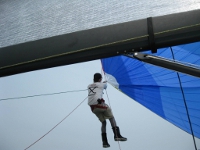#1 2014-12-20 10:06:59
- Worried Man
- Member

- From: Davebrubeckistan
- Posts: 15988
Weighing in on tropical-weight
MEN'S STYLE; TROPICAL EASE
By DIANE SUSTENDAL
Published: New York Times February 16, 1986
MEN ARE INCREASINGLY DISCOVERING that tropical-weight suits fulfill their business-dress needs throughout the year. What was once considered merely appropriate for warm or transitional climates is rapidly becoming the mainstay of the male wardrobe.
The reason is simple: these suits are comfortable, flexible and practical, as well as stylish.
A tropical-weight suit is made of fabric that weighs between seven and nine ounces per yard. The material may be wool or wool blended with polyester or rayon. Its cousin, the mid-weight suit, which weighs in at between nine and 11 ounces, is still popular for fall and winter but does seem to be losing considerable ground to tropical weights.
In 1984, Paul Stuart, the Madison Avenue haberdashery, began to stock versions of the tropical-weight suit for year-round wear. Today, they account for 50 percent of the store's suit sales. Barneys New York reports that tropicals amount to between 40 percent and 55 percent of all suit sales, and that the store has made a point of keeping such suits in stock all year. At Brooks Brothers, tropicals make up 75 percent of all suits sold during the spring; the mid-weight suit takes a 35 percent share of suits sold in the fall. Many large manufacturers - Hartmarx, Bidermann Industries U.S.A. and Ermenegildo Zegna, for example - originally produced these suits for men living in humid climates. Now, they say, the demand has moved northward. At Hartmarx, the most popular tropical-weight suits are made of all-wool worsteds or a blend of 55 percent polyester and 45 percent wool. These make up 80 percent to 85 percent of suit sales in the spring and 15 percent of sales in autumn. Bidermann Industries U.S.A., which produces more than 200,000 suits a season for Calvin Klein, Yves Saint Laurent and Daniel Hechter, classifies some 35 percent of the suits it makes as tropical weight. Three years ago, Zegna developed a seven-ounce, 100 percent Merino wool suit; it and the other tropicals, account for 90 percent of the suit business done in this country for spring and 25 percent for the winter.
What makes such a suit so popular? It is a logical choice for men who work and live in climate-controlled environments, as comfortable in a heavily heated building as in one highly air-conditioned. And it is flexible. In a dark color, it is an ideal choice for travel, equally appropriate in Paris, New York or Los Angeles. With a topcoat or lined raincoat, a man can board a plane in Chicago and disembark in San Diego, or vice versa, comfortably, and suitably, attired.
"We close our sto' at a reasonable hour because we figure anybody who would want one of our suits has got time to stroll over here in the daytime." - VP of George Muse Clothing, Atlanta, 1955
#2 2014-12-20 10:09:06
- Worried Man
- Member

- From: Davebrubeckistan
- Posts: 15988
Re: Weighing in on tropical-weight
I can get away with worsted tropical weight trousers year-round living in the Southeastern US, but it is nice to have something a bit heavier on the handful of really chilly days we get. It still snows here, after all.
"We close our sto' at a reasonable hour because we figure anybody who would want one of our suits has got time to stroll over here in the daytime." - VP of George Muse Clothing, Atlanta, 1955
#3 2014-12-20 16:04:31
- captainpreppy
- Member
- Posts: 1536
Re: Weighing in on tropical-weight
I know that these days most 9-ounce suitings are touted as "year round," with perhaps some justification. I don't if this was the case 28 years ago, though. Much to be said for the way heavier fabrics drape, but not worth sweating for here in the Sun Belt. I have one suit made from a 400g suiting (Harrison's Oyster), but I don't get many opportunities to wear it. However, I don't get many opportunities to wear a suit without being overdressed for the occasion these days, period.
#4 2014-12-20 19:10:36
- chatsworth osborne jr.
- Member

- Posts: 738
Re: Weighing in on tropical-weight
I have a tropical weight charcoal suit from years back that has proven fine for wear year round. Honestly, more so in winter than in summer. I can't recall ever feeling any coulder than I would in any other worsted suit.
#5 2014-12-21 08:22:22
- doghouse
- Member

- Posts: 5147
Re: Weighing in on tropical-weight
I've always had a conundrum on it. Heavier fabric (not LL approved 40000oz though) certainly makes it easier to cut a clean line, but with climate control, you end up being so damn hot.
Hide thy infants, hide thy Lady, and hide thy husband, alas they art forcing sexual intercourse upon the entire populace. - Wm Shakespeare
#6 2014-12-21 11:14:28
- Chévere
- Member

- From: Baltimore
- Posts: 856
Re: Weighing in on tropical-weight
1) Because I grew up in Puerto Rico where all male adult wore suits to work, the idea that clothing can be too hot was a given. It was a sign of being civilized, or of a certain level of breeding.
2) Lighter weight suits wrinkle too easily unless they have a lot of synthetics on them and then they don't breathe too well defeating the warm weather practicality.
3) Heavier weight fabric suits can really take a joke, especially when you travel.
4) One of my favorite summer jackets is a hopsack unlined blazer- the coarse weave and the fact that it is unlined really helps ventilation.
So although I know LL and various fora overdo the heavier weight fabric thing, I don't think the answer is "tropical weight" fabrics year round either.
Cógelo suave, pero cógelo.
#7 2014-12-25 06:18:22
- Beestonplace
- Member
- Posts: 1926
Re: Weighing in on tropical-weight
I like the 10oz Cordings suits, even in winter. Their 14oz twill is much too heavy.
I LOVE , this foum
#8 2014-12-26 00:33:06
- 4F Hepcat
- THE Cat

- Posts: 14333
Re: Weighing in on tropical-weight
A lot of the heavy cloth is effectively dead, even in winter: houses are warm, offices are warm, public transport is warm, your car is warm, restaurants and bars are warm. There's very little use for it outside of owning a stately home in the country that you can't afford to heat. Some of my heavy cloth jackets, tweeds and one suit where the trousers can practically stand(!) are only fit for purpose when the weather is near or below freezing. Same with my officer pinks.
Vibe-Rations in Spectra-Sonic-Sound
#9 2014-12-28 08:22:05
- doghouse
- Member

- Posts: 5147
Re: Weighing in on tropical-weight
^ Truth.
I was out to dinner last night for my brothers birthday, and wearing my newest Poole Check jacket, and I was pretty damn warm in the restaurant. Fairly annoying really, it was 45F out, should be able to wear a 12oz jacket no problem.
Hide thy infants, hide thy Lady, and hide thy husband, alas they art forcing sexual intercourse upon the entire populace. - Wm Shakespeare
#11 2014-12-28 15:07:44
- Worried Man
- Member

- From: Davebrubeckistan
- Posts: 15988
Re: Weighing in on tropical-weight
^
True. What works for one won't necessarily work for another.
"We close our sto' at a reasonable hour because we figure anybody who would want one of our suits has got time to stroll over here in the daytime." - VP of George Muse Clothing, Atlanta, 1955
#12 2014-12-28 16:26:13
- doghouse
- Member

- Posts: 5147
Re: Weighing in on tropical-weight
Hide thy infants, hide thy Lady, and hide thy husband, alas they art forcing sexual intercourse upon the entire populace. - Wm Shakespeare
